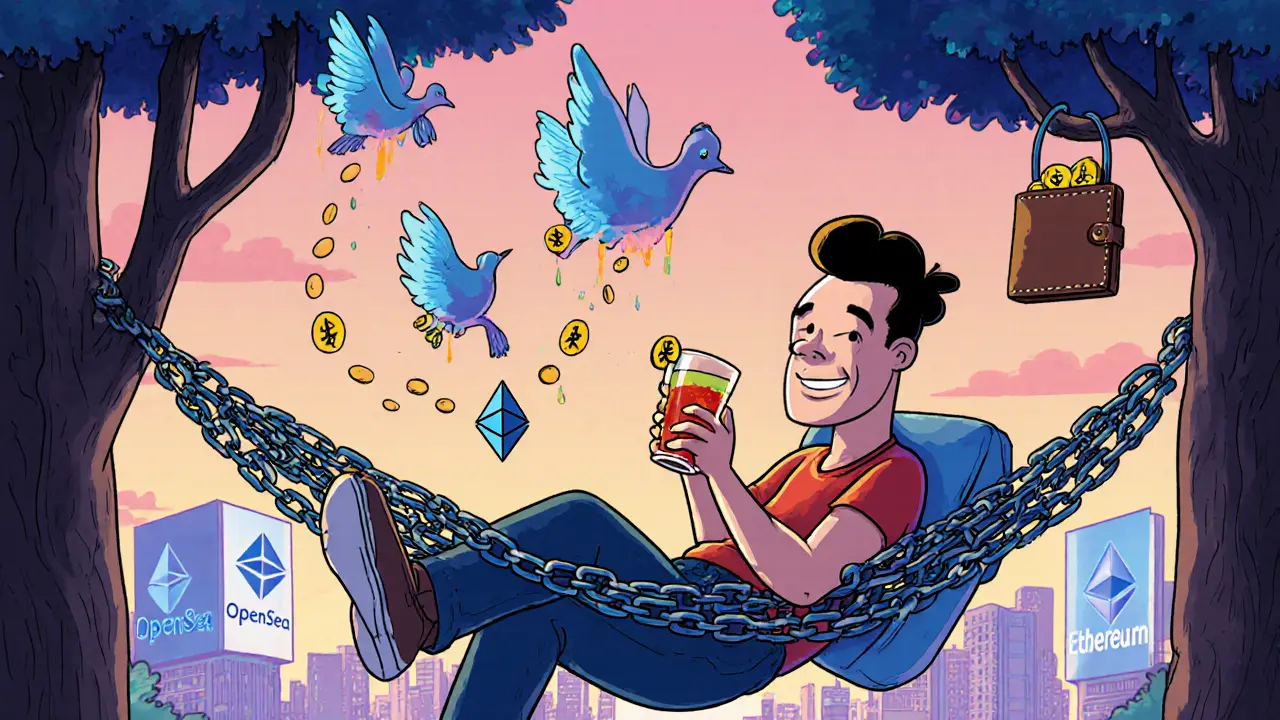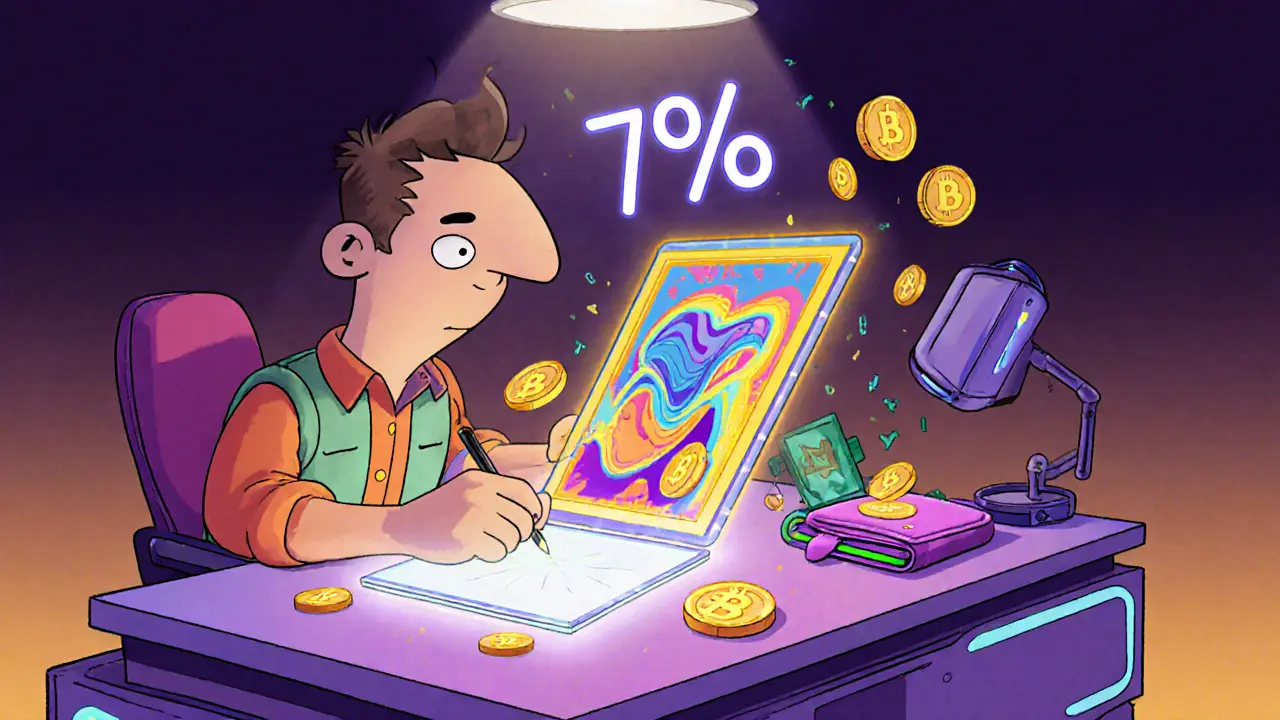NFT Royalty Calculator
Calculate Your Royalties
Imagine selling a digital drawing once-and then getting paid every single time someone resells it. No middlemen. No waiting. Just money automatically showing up in your wallet, years later. That’s not science fiction. It’s what NFT royalties do for artists today.
For decades, digital artists got stuck in a broken system. You spend weeks on a piece. Someone buys it. You get paid once. Then, five years later, that same piece sells for ten times more on a private server or a collector’s site. You see the sale. You know it’s your art. But you get nothing. Not a cent. That’s the old way. NFT royalties change that. They’re built into the code of the artwork itself, using blockchain technology to make sure you, the creator, keep earning every time your art moves hands.
How NFT Royalties Actually Work
NFTs-Non-Fungible Tokens-are unique digital certificates stored on a blockchain. Think of them like digital deeds for art, music, or videos. When you mint an NFT, you can set a royalty percentage right into the smart contract. That’s just a fancy word for a self-running program on the blockchain. It doesn’t need a human to approve it. It just works.
Let’s say you set a 7% royalty on your digital painting. Someone buys it for 2 ETH. Later, they sell it for 10 ETH. The smart contract sees that sale. It automatically takes 7% of 10 ETH (0.7 ETH) and sends it straight to your wallet. Done. No invoices. No emails. No delays. This happens every single time the NFT is resold, forever.
Unlike traditional art, where galleries and auction houses take 40-50% and you never see resale profits, NFT royalties put control back in your hands. You decide the percentage. You choose the platform. And the money? It’s yours, no matter who owns it next.
Real Money, Real Results
This isn’t theoretical. People are making serious cash.
In 2022 alone, over $1.8 billion in royalties were paid out on the Ethereum blockchain to digital creators. That’s billions flowing directly to artists, musicians, and designers-without a single gallery involved.
Take Yuga Labs, the team behind Bored Ape Yacht Club. They earned over $147 million in royalties from resales. That’s not a fluke. It’s the result of thousands of people buying and selling NFTs, with money automatically flowing back to the original creators.
Even smaller creators are seeing life-changing results. Musician Jacques Greene sold a 6-second audio loop as an NFT. He made $16,000 in royalties from resales. Compare that to his Spotify earnings: 7 million plays only brought him about $30,000 total. His NFT made him nearly half that-in just a few resales.
Some artists now make $5,000 to $10,000 a month just from royalties on their NFT collections. They don’t have to post daily. They don’t have to run ads. The art keeps selling. And they keep getting paid.
Why This Is a Game-Changer for Digital Artists
Before NFTs, digital art was seen as “easy to copy.” Why pay for it if anyone can screenshot it? That mindset made it nearly impossible to build a career as a digital artist. Royalties fix that.
Now, ownership is provable. Scarcity is enforced. And value appreciation? That’s yours too. When your art becomes popular, you benefit-not just the first buyer, not just a collector who flipped it, but you. The person who made it.
This changes everything. Artists can take risks. They can experiment. They can make weird, personal, niche work-and still know they’ll earn if it finds its audience. No more begging for commissions. No more waiting for a gallery to notice you. The market finds you, and your wallet grows with it.

What Royalty Percentages Work Best?
There’s no magic number. But the community has figured out what balances fairness and sales.
Most creators set royalties between 5% and 10%. The sweet spot? Around 5-7%. Why? Because buyers are smart. If you charge 15%, they’ll walk away. They don’t want to pay more upfront just so you keep taking a cut later.
On platforms like OpenSea, where most NFTs are traded, buyers expect royalties to be in that 5-7% range. Anything higher and you risk fewer sales. Anything lower, and you’re leaving money on the table.
Some creators use tiered royalties. For example: 8% on the first resale, then 5% after that. Others split royalties with collaborators-say, a musician and a visual artist on the same NFT. Smart contracts make this easy. You just program it in.
The Problems You Need to Know About
It’s not perfect. And you should go in with your eyes open.
Not all marketplaces enforce royalties. Magic Eden, for example, lets buyers disable them. Some traders use “NFT wrapping”-a sneaky trick where they repackage your NFT into a new one that bypasses the royalty code. That means you get nothing, even though your art sold.
Also, if you’re on a new or small platform, royalties might not even be supported yet. Always check: Does this marketplace honor creator royalties? If not, you’re better off listing elsewhere.
And yes, some buyers hate royalties. They see them as a tax. That’s why transparency matters. If you explain why you’re earning royalties-“I made this. I deserve to keep earning as it grows”-people get it. If you just slap on 10% and disappear? That’s when resentment builds.

How to Start With NFT Royalties
You don’t need to be a coder. Most platforms make it simple.
- Choose a platform that supports royalties: OpenSea, Blur, or Foundation are good starting points.
- Mint your artwork as an NFT. During the setup, you’ll see a field labeled “Royalty Fee” or “Creator Fee.”
- Set it between 5% and 7%. Don’t overthink it. You can adjust later if needed.
- Double-check: After minting, go to your NFT’s page and confirm the royalty is listed correctly.
- Promote your NFT. But don’t chase hype. Focus on building a real audience.
Once it’s out there, your job becomes easier. The blockchain does the rest. You get paid every time someone resells your work. It’s passive income, but it’s earned income-you built the thing. The system just makes sure you’re paid fairly.
What’s Next for NFT Royalties?
Right now, the system is still wild west. Some platforms enforce royalties. Some don’t. Some buyers try to cheat it. But the trend is clear: creators are demanding fairness.
More platforms are starting to lock in royalty enforcement. Legal systems are beginning to recognize blockchain-based rights. And artists? They’re no longer asking for permission. They’re building their own economies.
Soon, royalties might extend beyond art. Think music producers, writers, game developers, even educators selling digital courses as NFTs. The same rules apply: you make it, you own it, you earn from it-forever.
This isn’t a bubble. It’s a reset. For the first time, digital creators have a real shot at financial independence. No gatekeepers. No middlemen. Just your talent, your code, and a blockchain that never forgets who made what.
If you’re an artist making digital work, this is your moment. Not tomorrow. Not next year. Now.
Do NFT royalties work on all platforms?
No. Some platforms like OpenSea and Blur enforce royalties automatically. Others, like Magic Eden, allow buyers to disable them. Always check a platform’s policy before minting. If royalties aren’t enforced, your work won’t generate ongoing income, no matter what percentage you set.
Can I change my royalty percentage after minting?
Generally, no. Once an NFT is minted, the royalty percentage is locked into the smart contract. You can’t change it. That’s why it’s important to set it right the first time. If you’re unsure, start with 5-7%. You can always create new NFTs later with different terms.
How do I get paid from NFT royalties?
You need a crypto wallet like MetaMask or Phantom. When a resale happens, the royalty payment is sent directly to your wallet as cryptocurrency (usually ETH, SOL, or MATIC). You can hold it, trade it, or convert it to fiat through exchanges like Coinbase or Kraken. Payments are automatic-no invoices or bank transfers needed.
Are NFT royalties taxed?
Yes. In the U.S. and many other countries, royalty income from NFTs is treated as ordinary income or self-employment income. You’ll need to report it on your tax return. Keep records of every royalty payment you receive, including the date, amount, and transaction hash. Many creators use crypto tax tools like Koinly or TokenTax to track this automatically.
Can multiple artists share royalties on one NFT?
Absolutely. Smart contracts allow you to split royalties among multiple wallets. For example, if you made a digital painting with a musician who added sound, you can set 60% to your wallet and 40% to theirs. This is common in collaborative NFT projects and is one of the biggest advantages over traditional art deals, where splitting profits requires messy contracts.
